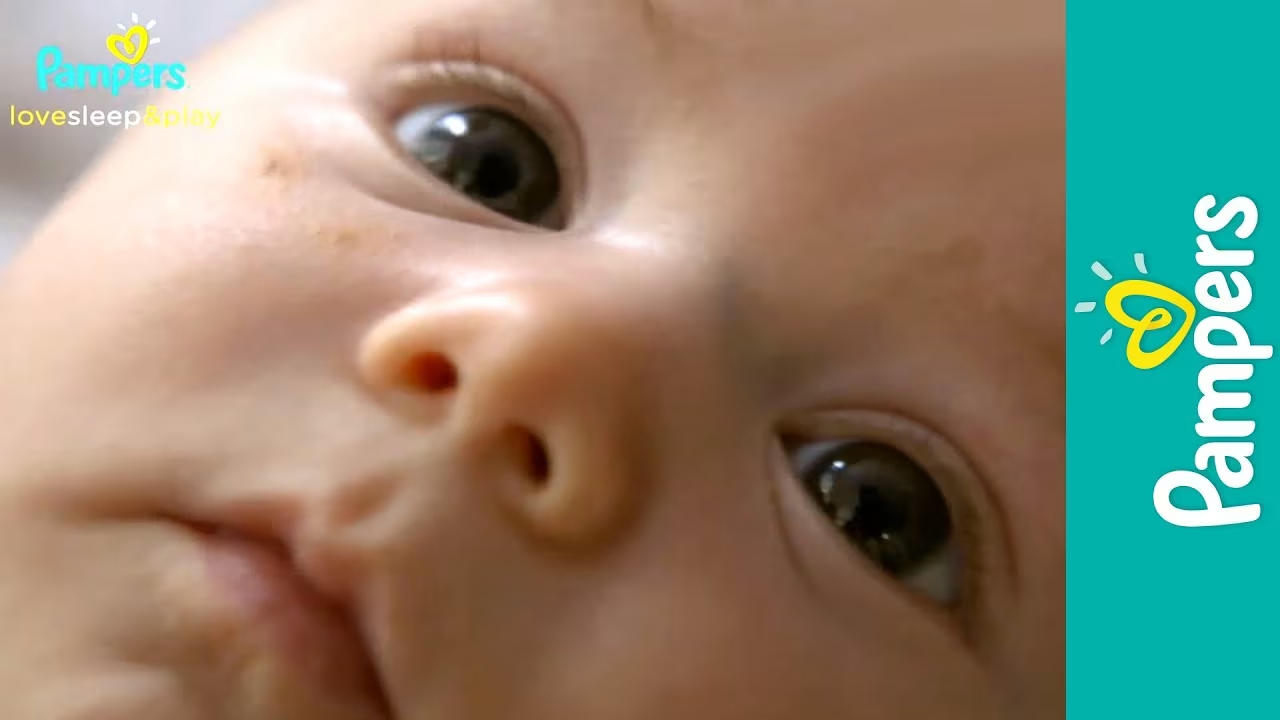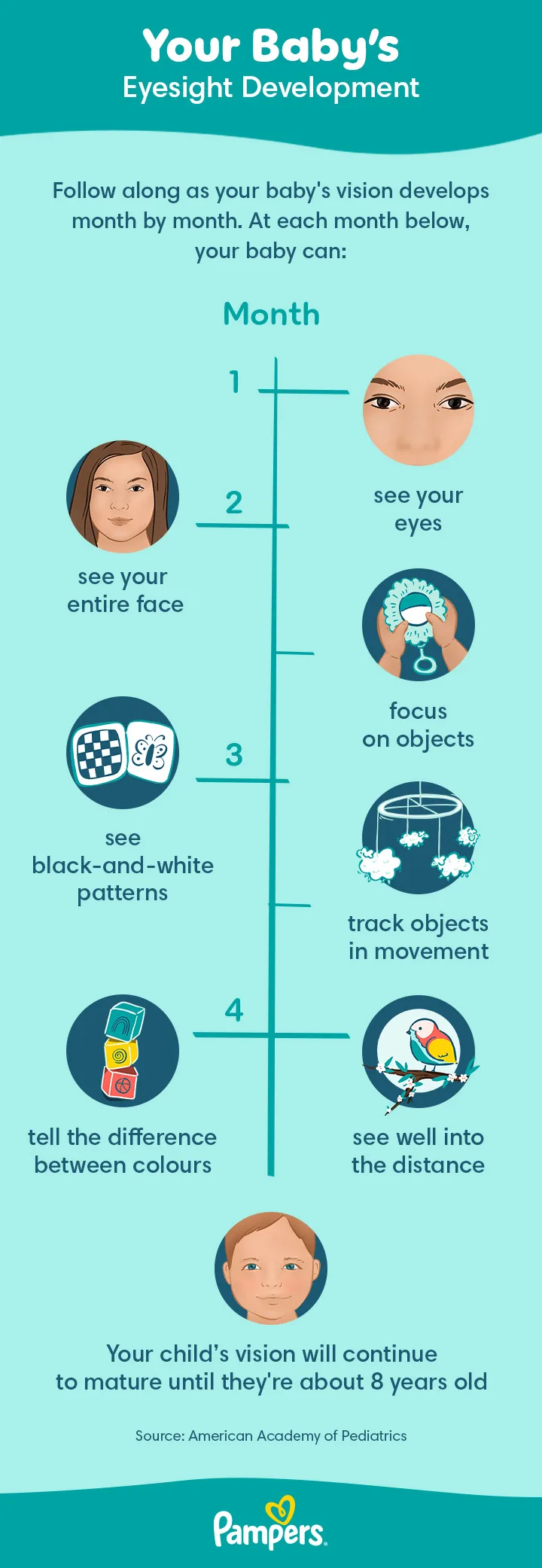Newborn Baby Eyesight: When Can Newborns See?
After marvelling at your newborn’s tiny fingers and toes, you might wonder about their eyesight. When can newborns see you? Can they recognize faces, track movement, or notice colours? Understanding newborn a baby's eyesight can help you support their visual growth. This guide explains how your little one’s vision develops when babies start seeing colour, how far they can see, and ways to encourage healthy visual milestones in the first year.
When Can Newborns and Babies See?
Newborns can open their eyes and see at birth, but their vision is limited. Even after birth, newborn eyesight is still developing, and they can only focus on things up to about 30 centimetres away. Anything beyond that appears blurry. Over the coming months, though, their vision will steadily improve, allowing them to see more clearly and respond to visual cues.
If your little one was born prematurely, their visual development may follow a slightly different timeline. Depending on how early they arrived, some premature babies may have closed or even fused eyelids at birth. However, their eyes typically open soon after birth as they continue to grow and develop.
Tip When you’re doing skin-to-skin contact with your newborn, try to position your baby facing you so that they can see you easily. Faces are a favourite visual stimulus for babies. |
When Do Babies Start Looking at You?
Your face is one of your baby’s favourite things to focus on. So, when do babies start seeing faces? From birth, newborns are naturally drawn to faces, especially the eyes, and may try to focus on yours when you’re holding them close. While their ability to see details is limited at first, newborn baby eyesight gradually sharpens.
Eventually, between 1 and 3 months of age, they’ll be able to take in more of your face, not just your eyes. And they’ll be more responsive to facial expressions that may involve your mouth, jaw, or cheeks.
Tip Babies love looking at faces—including their own. Try placing a baby-safe mirror at your little one’s eye level during playtime. It can offer engaging visual stimulation as they explore their reflection. |
How Far Can Newborns and Babies See?
From birth, your little one’s distance vision develops gradually. Newborn eyesight is limited to about 20 to 30 centimetres—the distance from your face when you’re holding or feeding them. Within this close range, they can study your features and respond to your expressions. Anything beyond that appears blurry, similar to how things look for an adult without their distance glasses.
Tip That 20- to 30-centimetre range is just right for bonding during feedings or cuddles. Take advantage of this special closeness to connect with your baby through eye contact. |
As your baby grows, their ability to see farther improves. You may wonder, “How far can a 3-month-old see?” Around 3 months, your little one may begin to notice you from across the room and might even offer a smile in response. They’ll also start focusing on nearby objects, like a toy lying just a short distance away.
By the time your baby is 4 months old, distance vision has progressed so much that they can stare out the window or look at something on the wall with interest, and by 7 months, their distance vision has improved greatly.
If your baby is around 4 months old, consider these stimulating play ideas.
What Can Newborns and Babies See?
So, what do infants see? At first, your little ones may not be able to look at you or focus on your face, though they can perceive light and shape as well as detect movement. Before long, your newborn’s eyes will meet your eyes; this is more likely to occur in low light than in bright light since their eyes are still very sensitive after leaving the darkness of the womb.
It’s also common to see your baby’s eyes drift or even cross from time to time. This usually resolves by about two or three months of age, once their eye muscles have strengthened and their newborn baby's eyesight improves.
The ability to see patterns and colour develops at roughly the same rate for your baby. However, it will be easier for your little one to detect patterns before they start being able to distinguish between similar colour hues. As development continues in your newborn baby's retinas—these are the light-sensitive tissues in the eyes—your little one will begin to see and recognize patterns, even by their first month. You may notice they will be drawn to simple black-and-white designs or those with strongly contrasting colours. At around 3 months old they may be able to perceive if there is more than one object in a picture.
The higher the contrast in a pattern, the more appealing it is to your baby, who may prefer to gaze at black-and-white patterns such as checks and stripes (at around 1 month) and bull’s-eyes and spirals (by 3 months old).
When Do Newborns and Babies See Color?
At birth babies mostly see the world in black and white, but it doesn't take long before they can tell the difference between one color and another. At birth, babies are sensitive to light (and don’t pick up on colour differences), but by 2 weeks of age their pupils enlarge and they’re able to experience a wider range of dark and light shades of colour. At about 1 month, your little one can detect the brightness and intensity of colours, and over the next few months may start to see several basic colours, including red. So, when do babies start seeing colour? Typically, by 4 months, most babies can see a wide range of colours and even distinguish subtle differences between them.
Tip Wondering what colours babies see first? Try holding three toys—one red, one blue, and one yellow—in front of your baby. Many babies are naturally more drawn to the red toy, possibly due to its brightness or contrast, though the exact reason remains unclear. |
When Can Babies Focus on Objects?
At birth, your little one cannot focus on things and track moving objects. No need to worry—these skills are developed over time.
Babies are born with peripheral vision, meaning they can see objects around them, at the sides of their visual field. But, being able to focus closely on a specific object is something that develops over time. They gradually can focus on a single point in the center of their visual field. By 1 month old they’ll be able to briefly focus on objects as far as three feet away.
By 2 or 3 months of age, your little one’s ability to focus may be developing steadily. Your baby may be able to turn both eyes inward, known as convergence, to focus on something nearby such as their hands. Simultaneously they will learn to turn both eyes outward, known as divergence, to focus on objects in the distance.
When Do Babies Start Tracking Objects with Their Eyes?
Tracking—the ability to follow a moving object with their eyes—starts to develop around 3 to 4 months of age. Early on, your newborn may struggle to focus on a moving toy, like a rattle, but by two months, they’ll have better control and may begin following it more steadily.
By three months, your baby might track smaller items and react more quickly to movement. They may also begin to look at your eyes to see what you’re focused on—an early sign of shared attention.
Tip One way to help your baby practice following a moving object with their eyes is to move your head from side to side as your baby faces you. Or try moving a patterned toy or object up and down or side to side in front of your little one. |
When your baby is about 3 months old, they will likely be able to use their arms and hands to swat at things in front of them (missing often). Practicing this hand-eye coordination is great fun for them and for you too!
Depth perception starts to develop at about 5 months after your little one has had some practice following objects coming toward them or away from them and can put together a three-dimensional view of the world.
Over time, as their motor skills improve, so will their aim and tracking ability.
Tip Hang a mobile over your baby’s crib or place one in front of their bouncy seat to provide visual stimulation and encourage tracking. You’ll need to retire the mobile at around 5 months when babies can reach mobiles and try to pull them down, which can lead to entanglement. |
Newborn and Baby Eye Development
Your baby’s eyesight develops rapidly in the first months, but full visual maturity takes time. While you’ll notice progress week by week, development continues through the toddler years. By three to five years old, most children can see as clearly as the average adult, and by around age 10, their visual system is fully developed.
In the early months, look for these milestones:
your baby can distinguish between colours like red, blue, and yellow with a strong preference for red
your baby likes complex patterns and shapes (try showing them popular children’s picture books)
your baby follows fast-moving objects with their eyes.
Newborn and Baby Visual Development
Take a look at our baby vision development chart below for a simple timeline of how your little one’s eyesight develops as they get older.
Your little one’s eyesight progresses from the moment they’re born, maturing rapidly throughout the first four months of life. Here are some key milestones to anticipate:
As a newborn your baby will look into your eyes, especially during skin-to-skin contact and feeding
By 1 month old your baby will see your entire face
By 2 to 3 months old their ability to focus will improve
At 3 months old they will enjoy looking at black-and-white patterns
By 3 to 4 months old they will be able to track objects and track in which direction you’re looking
By 4 months old they will be able to distinguish different colors, similar hues
After 4 months old they will be able to see very well into the distance, way past the 12 inches they saw at birth.
FAQS AT A GLANCE
From birth to 4 months, your baby’s eyesight is still developing. Hold your face close—newborn baby eyesight is best at 30 centimetres. Use high-contrast toys and gently move them side to side to encourage tracking and focus.
The Bottom Line
Your little one’s eyesight is just one part of their exciting journey through early development. As the weeks go by, enjoy watching your little one grow, explore, and respond to the world in new ways.
To learn more about typical development, check out growth milestones for babies on the Development Milestones. If you ever have concerns about your baby’s vision, consult your baby’s healthcare provider.
Want to save on essentials as your baby grows? Download the Pampers Rewards App for exclusive digital offers and discounts on Pampers products.
How We Wrote This Article The information in this article is based on expert advice found in trusted medical and government sources, such as the American Academy of Pediatrics and the American College of Obstetricians and Gynecologists. You can find a full list of sources used for this article below. The content on this page should not replace professional medical advice. Always consult medical professionals for full diagnosis and treatment.
Join Pampers Club and get:







